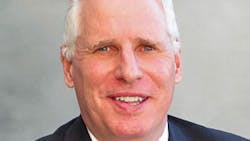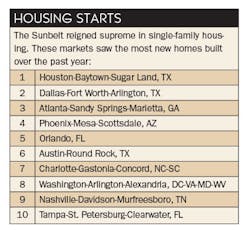The first installment of EW’s popular Electrical Markets 101 series on the residential market (see "Residential Market 101") highlights some interesting market data that shapes and measures the growth of the homebuilding industry. Some of the numbers in the data surprised EW’s editors, and we would like to share them with you here.
27% of one market’s residents didn’t live there just five years ago. In The Villages, FL MSA, the fastest-growing retirement community in the country, 21 out of every 100 residents didn’t live there back in 2010. No other MSA came near that sort of growth.
72,887. Every time I see that number in the U.S. Census Dept.’s 2015 annual total for the number of building permits for 5 units or more that were pulled in the New York-Newark-Jersey City, NY-NJ-PA MSA, I think it’s a typo. This is a massive, densely populated market area that covers three states, from the North Fork of Long Island; through the five boroughs of New York and Westchester County; much of the northern New Jersey suburbs; and over the Delaware River and into Pennsylvania’s Pocono Mountains.
The old 80-20 rule. The 100 MSAs with the most multi-family building permits account for 82% of the total multi-family activity (through Nov. 2016). In total, U.S. builders pulled 406,000 permits in this category and the Top 100 accounted for approximately 333,000 of them.
18 sunny Sunbelt markets rule the Top 25 markets for single-family housing starts. While big markets in the Northeast like New York and Philadelphia are also on this list because of their sheer size, it continues to amaze EW’s editors that so much of the residential construction activity is in the Sunbelt, or states known for their sunny or cloud-free climates, like Arizona, Colorado and Nevada. The states with the most MSAs in the Top 25 were Florida (4 MSAs), Texas (4 MSAs) and California (3 MSAs).
Dozens of sales opportunities in new-tech products for the home. While putting together this issue on the residential market, Executive Editor Doug Chandler had the opportunity to think about some of the newer products distributors may one day may sell into the home of the future (see "Homes Get Smart") — things like Elon Musk’s Tesla PowerWall and Tesla Solar Roof; electric vehicle chargers; Amazon’s Alexa-controlled Echo speaker; Google Home; Philips’ Wifi-enabled Hue Home Dimming System; Osram’s tunable Lightify LEDs; and the interactive Nest thermostat. Some of these products may seem a bit out there, but then again five years ago so did LED lighting systems that you can control from your smartphone.
About the Author
Jim Lucy
Editor-in-Chief of Electrical Wholesaling and Electrical Marketing
Jim Lucy has been wandering through the electrical market for more than 40 years, most of the time as an editor for Electrical Wholesaling and Electrical Marketing newsletter, and as a contributing writer for EC&M magazine During that time he and the editorial team for the publications have won numerous national awards for their coverage of the electrical business. He showed an early interest in electricity, when as a youth he had an idea for a hot dog cooker. Unfortunately, the first crude prototype malfunctioned and the arc nearly blew him out of his parents' basement.
Before becoming an editor for Electrical Wholesaling and Electrical Marketing, he earned a BA degree in journalism and a MA in communications from Glassboro State College, Glassboro, NJ., which is formerly best known as the site of the 1967 summit meeting between President Lyndon Johnson and Russian Premier Aleksei Nikolayevich Kosygin, and now best known as the New Jersey state college that changed its name in 1992 to Rowan University because of a generous $100 million donation by N.J. zillionaire industrialist Henry Rowan. Jim is a Brooklyn-born Jersey Guy happily transplanted with his wife and three sons in the fertile plains of Kansas for the past 30 years.

